How Long Does Champagne Last Opened
An opened bottle of champagne will last 1-3 days when properly stored with a specialized champagne stopper in your refrigerator at 40-45°F (4-7°C). You'll need to store the bottle upright and use an airtight seal to maintain carbonation and flavor. Without a proper stopper, your champagne will lose its bubbles within hours, even if you use the original cork. Temperature control is essential, so avoid storing it in the refrigerator door where temperatures fluctuate. If you notice changes in color, aroma, or taste, or if the bubbles have completely disappeared, it's time to discard the champagne. Understanding proper storage techniques can greatly extend your champagne's drinkability.
This post may contain affiliate links. If you make a purchase through these links, I may earn a commission at no additional cost to you. Additionally, portions of this post may be generated using artificial intelligence (AI) technology. While we strive for accuracy, please be aware that AI-generated content may not always be perfect and should be fact-checked when necessary.
The Spatula Scoops
- Properly sealed champagne with a specialized stopper lasts 3-5 days when stored in the refrigerator at 40-45°F (4-7°C).
- Using the original cork provides limited preservation, keeping champagne drinkable for only 1-2 days.
- Champagne stored at room temperature quickly loses carbonation and should be consumed within 24 hours.
- Signs of spoiled champagne include color changes to brown, loss of bubbles, and vinegar-like or sour tastes.
- Temperature, seal integrity, and exposure to air are the main factors affecting opened champagne's shelf life.
Understanding Champagne Storage Basics
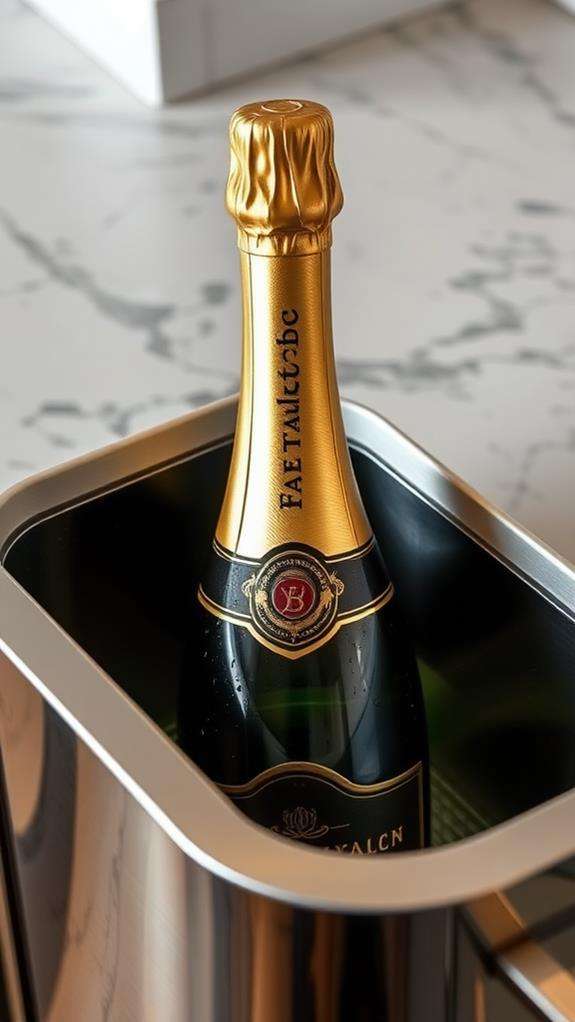
Champagne's quality and longevity depend heavily on proper storage techniques. When you're storing an opened bottle of champagne, you'll need to take into account several important factors that affect its preservation, including temperature, light exposure, and positioning.
You'll want to keep your opened champagne in a cool environment, ideally between 40-45°F (4-7°C), as warmer temperatures can speed up the deterioration process and cause the bubbles to dissipate more quickly. Your refrigerator's main compartment is usually perfect for this purpose. It's essential that you store the bottle upright, not on its side, as this helps maintain carbonation and prevents unnecessary leakage.
You should also protect your champagne from direct light exposure, as UV rays can trigger chemical reactions that alter the wine's taste and aroma. While most refrigerators provide adequate darkness, if you're storing the bottle elsewhere, you'll want to keep it away from windows and bright artificial lights. Using a champagne stopper, rather than the original cork or a standard wine stopper, will create an airtight seal that helps preserve the bubbles and maintain the wine's effervescence.
Factors Affecting Opened Champagne Quality
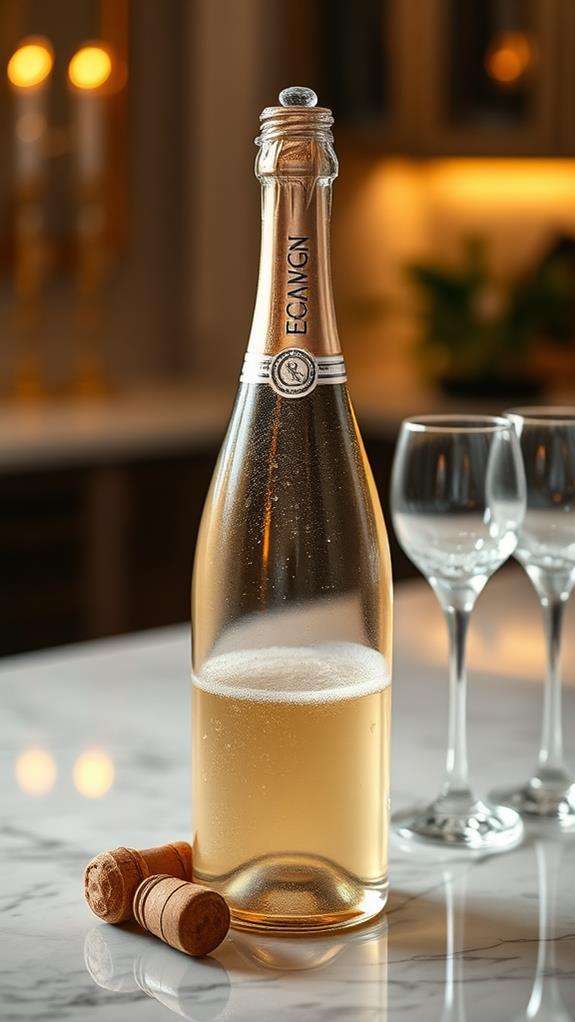
The quality of your opened champagne depends heavily on three critical factors that you'll need to monitor closely. Your storage temperature and location should remain consistently cool and dark, while the tightness of your champagne stopper or specialized sealing device needs to maintain proper pressure to prevent excessive carbonation loss. Most importantly, you'll want to minimize your champagne's exposure to air, as oxygen will quickly break down the wine's aromatic compounds and diminish its distinctive effervescence.
Temperature and Storage Location
Proper storage regarding temperature and location plays a critical role in preserving opened champagne's fizz and flavor. You'll want to store your opened bottle in a consistently cool environment between 40-45°F (4-7°C), as temperature fluctuations can quickly degrade the wine's quality. Your refrigerator's main compartment typically provides an excellent setting, but avoid the door shelf where temperatures vary frequently.
| Storage Location | Temperature Range | Impact on Quality |
|---|---|---|
| Refrigerator Main | 40-45°F (4-7°C) | Optimal preservation |
| Door Shelf | Variable | Rapid degradation |
| Room Temperature | 68-72°F (20-22°C) | Quick loss of bubbles |
| Wine Cellar | 55-60°F (13-16°C) | Moderate preservation |
Position your bottle upright, not on its side, to minimize the surface area exposed to oxygen. You'll also want to keep it away from strong odors, as champagne can absorb surrounding aromas through the cork. If you don't have access to a refrigerator, you can use a champagne stopper and place the bottle in the coolest, darkest part of your home, though this isn't ideal for long-term storage.
Cork Tightness Matters
Beyond temperature control, maintaining a secure seal on your opened champagne bottle greatly impacts its longevity. When you're storing an opened bottle, you'll want to make sure the champagne stopper or cork is inserted firmly and straight, creating an airtight barrier that prevents excessive oxidation and carbonation loss. You can test the tightness by gently tilting the bottle to see if any liquid seeps around the cork's edges.
For the best results, you'll need to invest in a proper champagne stopper with a hinged clamp mechanism, as these devices create a much better seal than simply trying to reinsert the original cork. These specialized stoppers typically feature a rubber gasket that forms an airtight seal and metal wings that lock under the bottle's lip. If you don't have a champagne stopper handy, you can use plastic wrap secured with a rubber band as a temporary solution, though this isn't ideal for more than a few hours. Remember that even with the tightest seal possible, opened champagne will gradually lose its bubbles and fresh taste, so you should plan to consume it within 1-3 days.
Exposure to Air
Every time you open your champagne bottle, exposure to air kickstarts the oxidation process, which gradually diminishes the wine's distinct flavors and effervescence. This chemical reaction occurs when oxygen molecules interact with the wine's compounds, transforming its taste profile and reducing its signature bubbles.
You'll notice the effects of oxidation most prominently within the first few hours after opening. The champagne's crisp, fresh notes will slowly shift to more muted, sometimes slightly bitter flavors, and you'll see fewer bubbles rising to the surface. To minimize air exposure, you shouldn't leave your opened bottle sitting upright without a stopper, as this creates maximum surface area for oxidation.
When you're storing partially consumed champagne, you'll want to use a specialized champagne stopper that creates an airtight seal. Position the bottle at a 45-degree angle in your refrigerator, which helps maintain pressure and reduces the wine's surface area exposed to trapped air. Even with these precautions, you're working against time, as the oxidation process continues slowly but steadily once it begins, regardless of your storage method.
Proper Champagne Preservation Methods
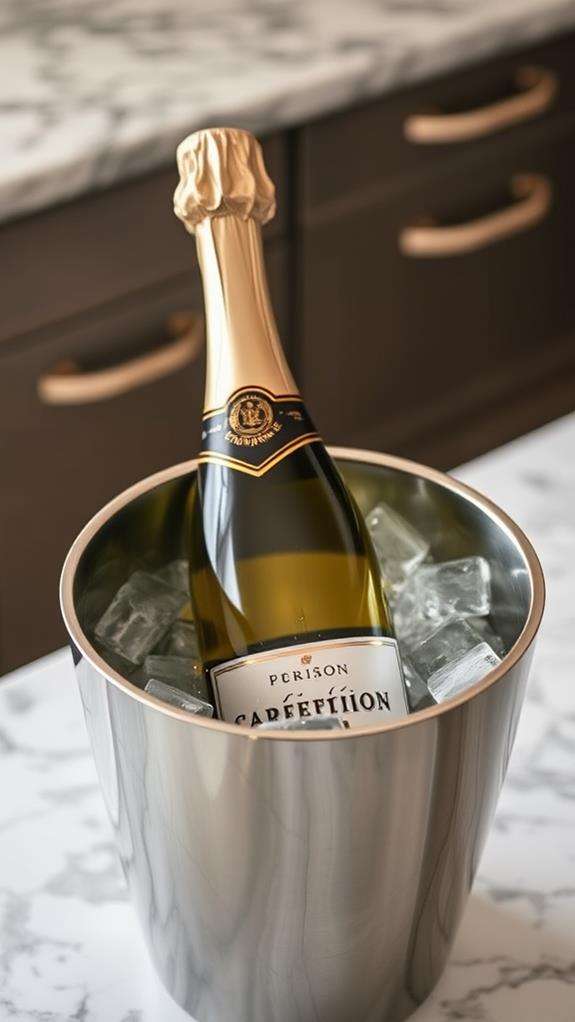
To maintain your champagne's quality after opening, several essential preservation methods can help extend its lifespan. You'll want to focus on temperature control, proper sealing, and minimizing exposure to light, as these factors markedly impact the wine's flavor and effervescence.
Here are the most effective preservation techniques you should follow:
- Store your opened champagne at a consistent temperature between 40-45°F (4-7°C) in your refrigerator, as temperature fluctuations can quickly degrade the wine's quality and accelerate the loss of bubbles.
- Use a specialized champagne stopper that creates an airtight seal, rather than trying to reinsert the original cork, which won't maintain proper pressure and can allow excess oxygen to enter.
- Keep the bottle upright in your refrigerator's door compartment, as this position helps maintain carbonation and prevents unnecessary movement that could release dissolved gases.
Remember to handle your opened bottle gently when removing or replacing it from storage, as any aggressive movement can cause the remaining carbonation to escape. If you're planning to store the champagne for more than a day, consider investing in a vacuum sealer specifically designed for sparkling wines.
Signs of Spoiled Champagne
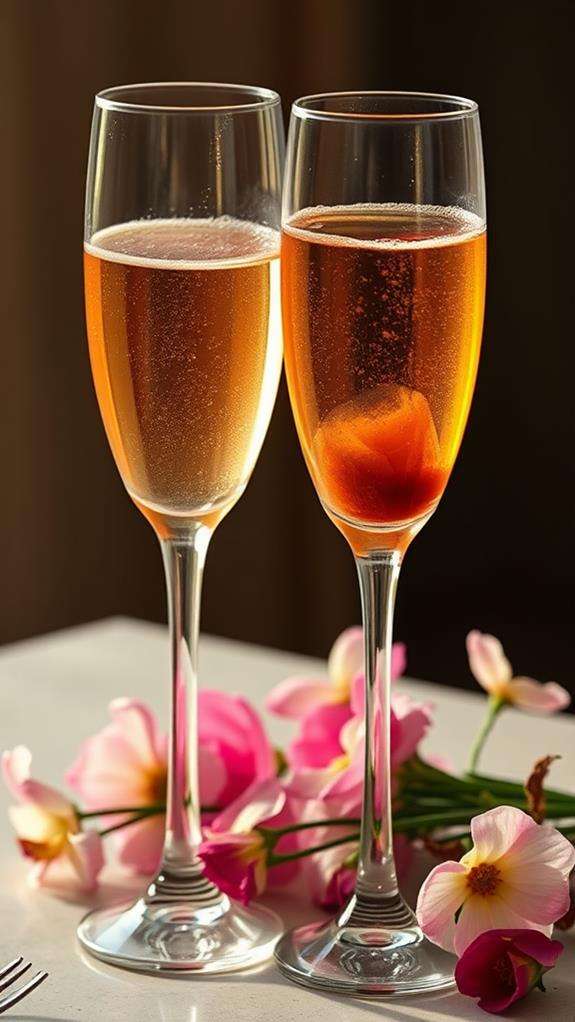
You'll notice your champagne has spoiled if it develops a strange brown or yellow tint, loses its signature bubbles, or shows any signs of floating particles. When it comes to smell and taste, spoiled champagne often gives off vinegar-like or stale aromas, completely different from its usual crisp, yeasty scent. If you detect any of these changes, or if the taste becomes unpleasantly sour or flat, it's best to discard the bottle rather than risk consuming compromised champagne.
Visual Changes
Clear visual indicators can help you determine if your champagne has gone bad. When examining your opened bottle, you'll want to look for specific changes that signal deterioration in the wine's quality. The appearance of your champagne can tell you a lot about whether it's still safe and enjoyable to drink.
- Color changes – Your champagne should maintain its characteristic golden-yellow or pale straw color. If you notice it's becoming darker, taking on brown or orange hues, or appearing cloudy, it's likely oxidized and past its prime.
- Sediment formation – While some aged champagnes naturally develop sediment, unexpected particles or floating debris in a recently opened bottle isn't normal. You might see small crystals or flakes that weren't present when you first opened the bottle.
- Bubble behavior – Fresh champagne should display consistent, vibrant effervescence with streams of tiny bubbles rising to the surface. If you're seeing larger, irregular bubbles or the wine appears completely flat with no carbonation, it's lost its signature sparkle and won't provide the intended experience.
Taste and Smell Issues
Taste-and-smell evaluation provides the most reliable indicators of spoiled champagne. When you're examining your opened bottle, you'll notice that fresh champagne should have crisp, fruity notes with hints of citrus, apple, or berries, depending on the variety. If these pleasant aromas have been replaced by vinegar-like, musty, or cardboard-like smells, your champagne has likely spoiled.
You'll want to pay attention to specific taste markers that signal deterioration. Fresh champagne offers a balanced combination of acidity and sweetness, but when it's gone bad, you'll detect harsh, sour flavors that overwhelm the wine's natural characteristics. If your champagne tastes flat, lacks its signature effervescence, or has developed an unpleasant metallic aftertaste, it's past its prime. Chemical changes have occurred, breaking down the delicate flavor compounds that give champagne its distinctive profile.
Don't confuse the natural yeasty notes found in some champagnes with spoilage. However, if you detect flavors reminiscent of cooked cabbage, wet newspaper, or paint thinner, these are clear indicators that the champagne has oxidized and shouldn't be consumed.
Temperature and Storage Environment
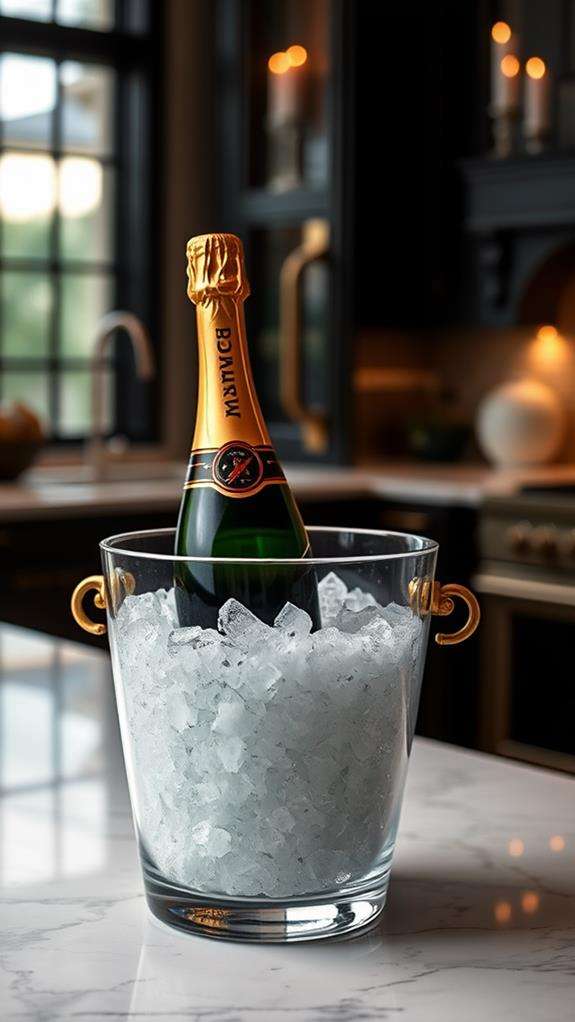
Proper temperature control and storage conditions play an essential role in preserving opened champagne's quality. You'll want to keep your opened bottle in a consistently cool environment, as temperature fluctuations can quickly degrade the wine's character and carbonation. The ideal storage temperature ranges from 40-45°F (4-7°C), which you'll typically find in your refrigerator's main compartment.
To maximize your opened champagne's longevity, follow these important storage guidelines:
- Store the bottle upright, not on its side, to minimize the surface area exposed to oxygen and help maintain carbonation.
- Use a specialized champagne stopper that creates an airtight seal, as the original cork won't effectively reseal once removed.
- Keep the bottle away from direct sunlight and heat sources, including your kitchen's ambient lighting and appliances.
Your storage environment's humidity levels also matter. You'll want to avoid extremely dry conditions, which can cause the cork to shrink and allow more oxygen into the bottle. If you're storing the champagne in your refrigerator, remember that the dry environment might affect the cork's seal, so using an airtight stopper becomes even more vital.
Best Storage Tools
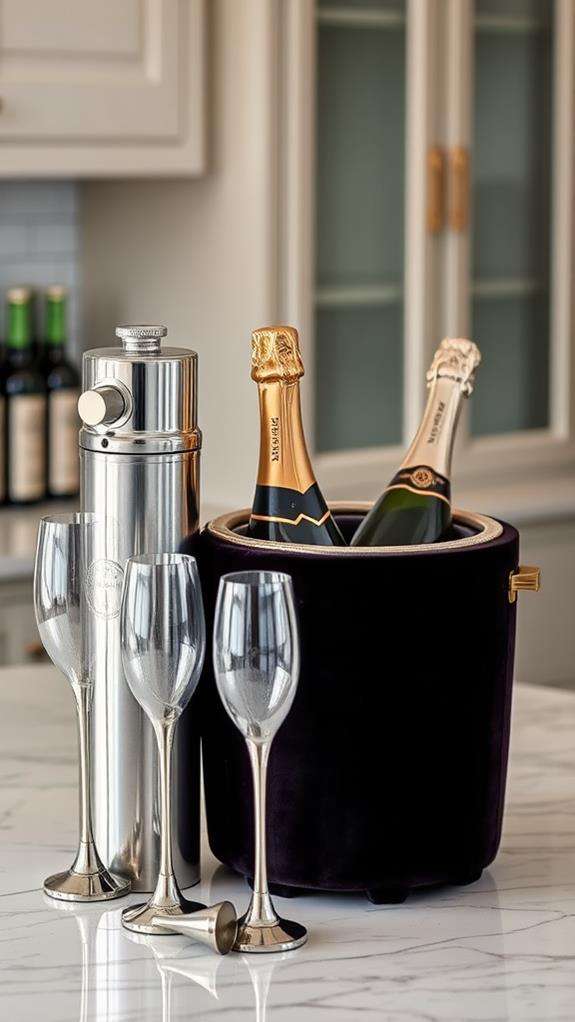
When storing opened champagne, you'll want to invest in specialized tools like champagne stoppers and sealers, which create an airtight seal to preserve the bubbles much better than the original cork. Wine preservation systems, including vacuum pumps and inert gas sprays, can help remove oxygen and create a protective barrier that extends your champagne's drinkability for several days. For the best results, transfer any remaining champagne to a smaller container that leaves minimal air space, as this reduces oxidation and helps maintain the wine's effervescence and flavor profile.
Champagne Stoppers and Sealers
Investing in the right champagne stopper can greatly extend your opened bottle's lifespan and maintain its effervescence. When you're selecting a stopper, you'll want to focus on designs that create an airtight seal while withstanding the pressure from the carbonation. The most effective stoppers typically feature a clamp mechanism that secures firmly to the bottle's neck.
For maximum preservation of your opened champagne, consider these high-quality stopper options:
- Hermetic Lever-Seal Stoppers – These feature a hinged lever that clamps down to create a pressure-tight seal, often including a rubber gasket for enhanced security
- Stainless Steel Expanding Stoppers – They use an expansion mechanism that fits various bottle sizes, with internal rubber seals that compress against the bottle's interior
- Vacuum-Seal Systems – These remove excess air from the bottle while securing the closure, though they're typically more expensive than standard stoppers
You'll find that the best champagne stoppers maintain pressure for up to 5 days, though results vary based on the stopper's quality and how well you've secured it. Remember to store your sealed bottle upright in the refrigerator to maximize preservation effectiveness.
Wine Preservation Systems
Beyond traditional stoppers, advanced wine preservation systems offer superior protection for your opened champagne and other fine wines. These sophisticated devices use inert gases, like argon or nitrogen, to create a protective barrier between your champagne and oxygen, greatly extending its drinkability.
You'll find several effective preservation systems on the market, including the popular Coravin and Private Preserve. The Coravin system lets you access your wine without removing the cork, using a thin needle and pressurized argon gas to extract the liquid while preventing oxidation. If you're looking for a more budget-friendly option, Private Preserve's spray system displaces harmful oxygen with a blend of inert gases.
For champagne specifically, you'll want to evaluate systems designed for sparkling wines, such as the Perlage preservation system. It's specifically engineered to maintain carbonation while preventing oxidation. These systems typically include a specialized stopper and gas cartridge that work together to preserve both the bubbles and flavors of your opened champagne for up to two weeks, compared to just 1-3 days with traditional stoppers.
Proper Storage Containers
Selecting the right storage container can make or break your champagne's longevity after opening. To maintain those precious bubbles, you'll need a specialized solution that's designed specifically for sparkling wines. The right container will create an airtight seal that prevents carbonation from escaping while protecting the wine from oxidation.
For ideal champagne preservation, consider these essential storage options:
- Champagne stoppers with a hinged clamp – These specially designed stoppers create an airtight seal by latching onto the bottle's lip, maintaining pressure and preventing the escape of carbonation for up to 3-4 days
- Original bottle with hermetic sealer – If you've kept the original cork, you can pair it with a vacuum-sealed hermetic cap that removes excess air and creates a tight seal
- Specialized champagne preservation bottles – These containers feature pressure-lock systems and are made from thick, dark glass that shields the wine from light damage while maintaining consistent temperature
Remember that even with the best storage container, you'll want to keep your opened champagne in the refrigerator at a consistent temperature between 40-45°F (4-7°C) to maximize its lifespan.
Serving Previously Opened Champagne
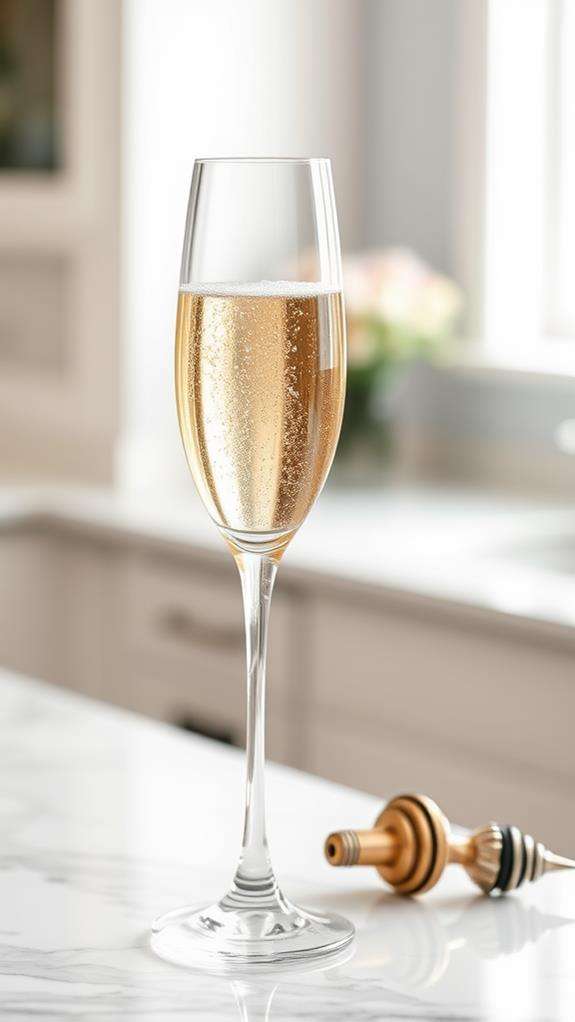
When you're ready to serve previously opened champagne, proper temperature and handling make a significant difference in its remaining quality. You'll want to remove the bottle from storage at least 30 minutes before serving, allowing it to reach the ideal temperature of 45-50°F (7-10°C).
| Serving Aspect | What to Do | What to Avoid |
|---|---|---|
| Temperature | Chill to 45-50°F | Don't over-chill |
| Pouring Method | Tilt glass at 45° | Don't pour straight down |
| Glass Type | Use flutes or tulips | Avoid wide coupes |
| Timing | Serve immediately | Don't let it sit out |
Before serving, you'll need to assess the remaining carbonation. Give the bottle a gentle tilt to check for bubbles rising from the bottom. If you're seeing active effervescence, you can serve it as usual. If the bubbles are minimal, you might want to contemplate using your champagne in cocktails or cooking. When pouring, handle the bottle gently to preserve any remaining carbonation, and serve in proper champagne flutes that'll help maintain the bubbles longer. Remember, even if the champagne has lost some sparkle, it can still offer pleasant flavors when served at the right temperature.
Common Storage Mistakes
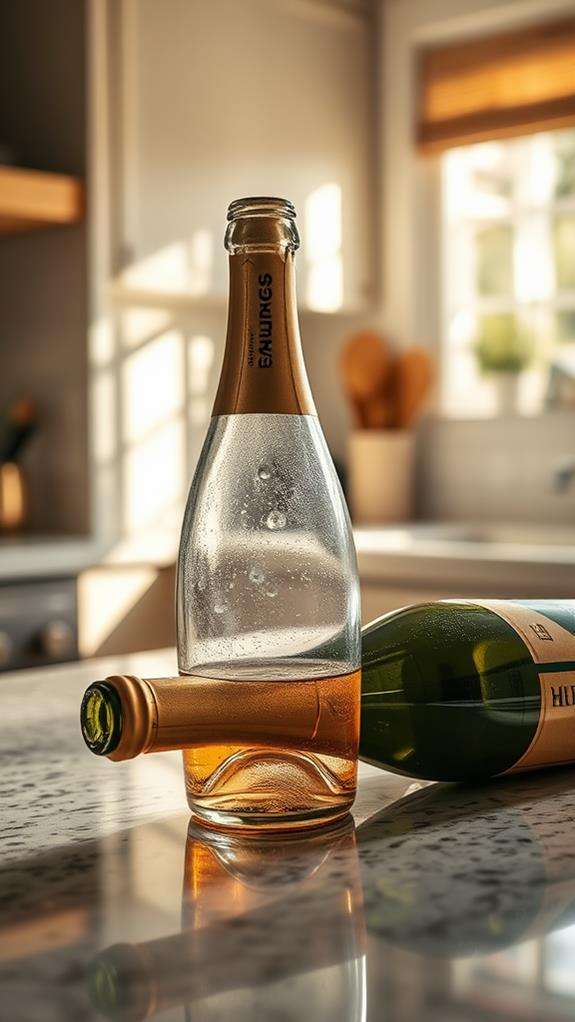
Many champagne enthusiasts unknowingly compromise their opened bottles through several common storage mistakes. You're probably making some of these errors without realizing how they're affecting your champagne's quality and longevity. Understanding these mistakes can help you preserve your bubbly's effervescence and flavor profile more effectively.
Here are the most critical storage errors you'll want to avoid:
- Storing your opened champagne without a proper champagne stopper – a regular wine cork won't maintain adequate pressure, leading to rapid carbonation loss
- Keeping the bottle upright instead of horizontal – this reduces the wine's contact with the cork, which can cause it to dry out and allow more oxygen to enter
- Placing your opened champagne in the door of your refrigerator – the frequent temperature fluctuations from opening and closing the door will destabilize the wine's composition
You'll also want to avoid storing opened champagne at room temperature or in areas with direct sunlight. The ideal storage temperature is between 40-45°F (4-7°C), and you should keep the bottle in the main compartment of your refrigerator where temperature remains consistent.
Extending Your Champagne's Lifespan
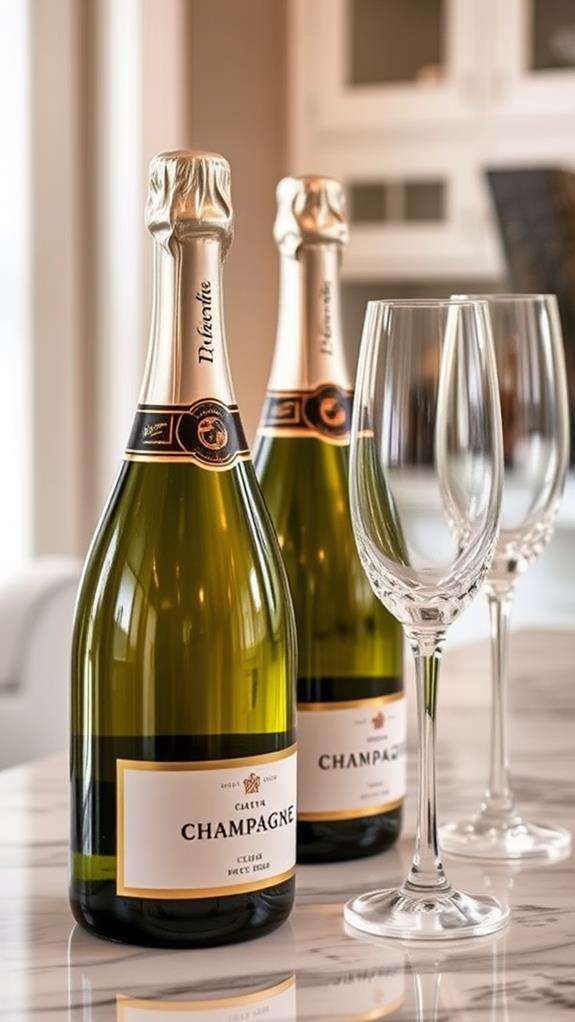
To maximize your opened champagne's lifespan, you'll need to implement several preservation techniques immediately after your first pour. Taking proper steps will help maintain the bubbles and flavor profile for up to 5 days when stored correctly.
| Storage Method | Effectiveness | Duration |
|---|---|---|
| Champagne Stopper | High | 3-5 days |
| Original Cork | Medium | 1-2 days |
| Plastic Wrap | Low | 24 hours |
| Spoon Method | Very Low | 12-24 hours |
You'll get the best results by investing in a specialized champagne stopper that creates an airtight seal. These stoppers lock in the carbonation and prevent oxidation, which can quickly degrade your wine's quality. Store the bottle upright in your refrigerator, as this position helps retain the bubbles better than laying it on its side.
If you don't have a proper stopper, you can use the original cork as a temporary solution, though it won't create as tight a seal. Remember to check the temperature regularly, aiming to maintain it between 40-45°F (4-7°C). These preservation methods work best when combined with consistent temperature control and minimal exposure to light.
Alternative Uses for Flat Champagne
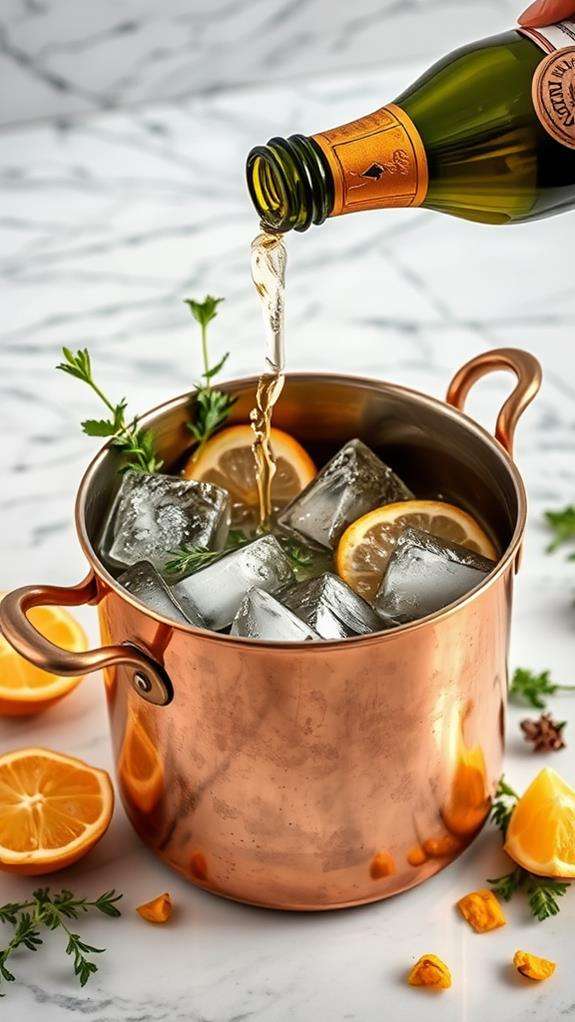
Several creative uses exist for flat champagne that's lost its bubbles, so there's no need to pour it down the drain. The alcohol and acidic properties of champagne make it versatile for both culinary and household applications, even after it's lost its effervescence.
- Cooking Applications: You can use flat champagne as a deglazing agent for pan sauces, adding depth to risottos, or creating champagne vinaigrettes. The wine's acidity helps tenderize meats in marinades while adding subtle flavor complexity.
- Beauty Treatments: The natural acids in champagne can benefit your hair and skin. You'll find it works well as a clarifying hair rinse or when added to bath water for a luxurious soak that may help balance your skin's pH levels.
- Household Solutions: Your flat champagne's acidic properties make it effective for cleaning glass surfaces and mirrors. You can also use it to polish brass or copper items, as the wine's compounds help remove tarnish while restoring shine.
Remember to store your repurposed flat champagne in an airtight container in the refrigerator if you're planning to use it for cooking or beauty treatments within the next few days.
Frequently Asked Questions
Can I Get Sick From Drinking Expired Champagne?
You won't likely get sick from drinking expired champagne, but it might taste unpleasant. While the alcohol content helps prevent harmful bacteria growth, expired champagne can develop off-flavors and lose its signature bubbles. If the bottle's been properly stored and doesn't show signs of contamination (odd colors, mold, or strange odors), it's generally safe to drink but won't offer the best taste experience you're looking for.
Does Mixing Champagne With Juice Make It Last Longer?
Just like adding water to a wilting flower won't revive it permanently, mixing champagne with juice won't extend its lifespan. In fact, you're adding more organic compounds that can accelerate spoilage. Your champagne-juice mixture will still lose its bubbles within 24-36 hours, and you'll need to consume it within 3-4 days when refrigerated. If you're planning to mix drinks, it's best to do so right before serving.
Why Does Some Champagne Taste Better the Next Day?
While it's uncommon, you might find your champagne tastes better the next day because some oxidation can actually enhance certain flavor profiles. When you leave champagne overnight, it'll lose some carbonation, which lets you taste the wine's subtle notes more clearly. You'll notice this particularly with fuller-bodied champagnes, where the fruit and yeast characteristics become more pronounced once the bubbles settle down and the wine opens up.
Can I Freeze Leftover Champagne Into Ice Cubes?
While you can freeze champagne into ice cubes, you won't get the results you're hoping for. When frozen, champagne loses its carbonation and distinctive flavor profile. You'll end up with flat, slightly alcoholic ice cubes that don't taste like champagne. Instead of freezing, you're better off using leftover champagne for cooking or making cocktails. If you need to chill champagne quickly, regular ice cubes work best.
Does the Champagne Brand Affect How Long It Stays Fresh?
Yes, the brand of champagne does affect its freshness duration after opening. You'll find that higher-quality champagnes, especially those with more complex production methods and better ingredients, typically maintain their bubbles and flavor profile longer than budget options. However, regardless of brand, you shouldn't expect more than 3-4 days of peak taste when properly stored with a champagne stopper in your refrigerator at around 40°F (4°C).





